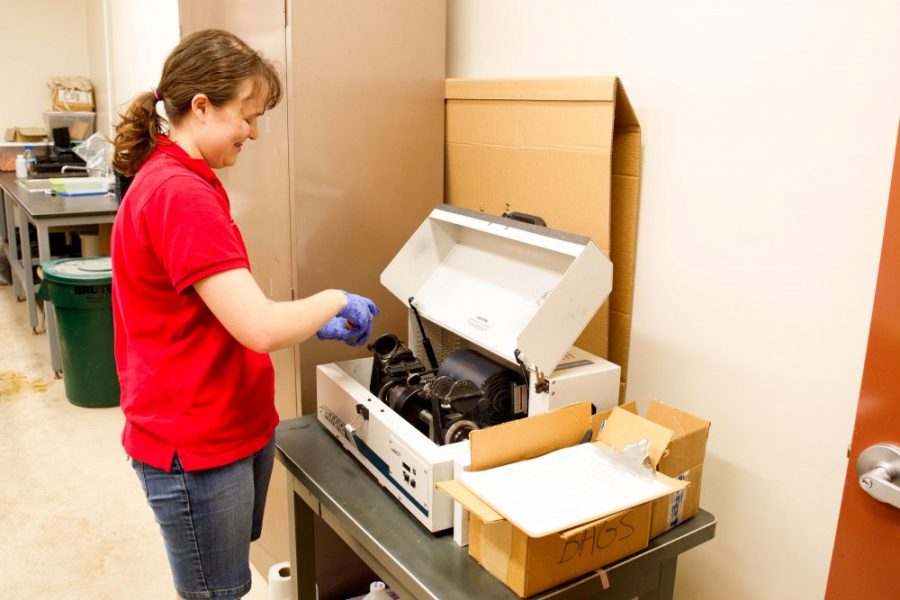For many students, working a part-time job allows them to have extra spending money or the chance to pay off some debt. Students often look for jobs in food service or retail, but at the UA, employment options aren’t limited there.
Students can find jobs that provide a rewarding experience, life-long memories and the chance to make some extra cash through the vast network of on-campus research labs. From cognitive studies to microbes and permafrost, the UA’s on-campus labs have something for every scientific mind.
Microbiology senior Kevin Ackman works on-campus in Dr. Michael Riggs’ Immunoparasitology Lab. The lab is developing a more effective drug treatment for the waterborne pathogen Cryptosporidium.
He first heard about the opportunity to be a lab assistant through emails his academic advisor sent out on a regular basis. Although he was initially hoping to volunteer in a lab, Ackman jumped at the opportunity to be paid to participate in research.
In the year that Ackman has worked in the lab, he said he gained valuable experience that helped him grow as a microbiologist.
“I’ve learned techniques that are the everyday life of a microbiologist,” Ackman said. “The techniques most valuable go past just the data collection, DNA isolation, fluorescent analysis, etc. I feel like I’ve already started my career in this lab and that’s what I love the most.”
Ackman said becoming an undergraduate researcher has been valuable in helping prepare him for job-hunting after college.
“If you are looking for a certain kind of career and you have the opportunity to do that kind of work here on campus there is no reason you should pick the retail job,” Ackman said. “I have to think that here at a the UA lab, I’m treated with far more respect as an individual. I’m not sure if I could be as involved in a traditional job.”
Rose Vining, an environmental sciences senior, works in the Saleska Lab in Biosciences West. She is co-mentored by UA Soil, Water and Environmental Science affiliate, professor Virginia Rich. She first became interested in becoming an undergraduate researcher when she saw a presentation on the Undergraduate Biology Research Program in her Careers in Environmental Science course. She decided to apply and was accepted into the program the summer between her freshman and sophomore year.
At the lab, Vining started out by analyzing data on microorganisms of the Great Barrier Reef. She thought the work was interesting, but soon realized it was not her forte.
“After that [Great Barrier Reef] project came to a close, I talked to my mentor about what I was really interested in and she told me about the permafrost project she was working on with permafrost thaw gradients,” Vining said. “She gave me the option to work with either viruses or plants, and I chose plants because I felt that it would be a totally different change for me.”
In the summer of 2015, Vining was lucky enough to travel to Abisko, Sweden to conduct fieldwork thanks to the funding from the Biomedical Research Abroad: Vistas Open!, or BRAVO!, program within UBRP.
“Long before the trip even happened, I had to write a proposal,” Vining said. “I had to make a case in front of a bunch of scientists. At first they were a little bit nervous about funding me because I am younger, but ultimately they were able to do it. I was able to go for two months over the summer.”
While in Sweden, Vining waded through knee-high freezing water to take plant biomass samples. The soil beneath the sample area is the concrete-like permafrost, which generally stays frozen year-round. Due to climate change, though, the permafrost is thawing, causing the water to infiltrate into the soil and create a slushy peat material, which eventually becomes completely waterlogged.
“It was really shocking to see because we also had a bunch of boardwalks that were put into our field site several years ago and they were noticeably collapsing,” Vining said. “So it was clear that there had been a lot of changes in this site over the span of a few years.”
Currently, Vining is working on data analysis of the samples she collected in Sweden. She has been grinding plant samples for analyses to determine how biodegradable the material is and how much total biomass is contained at the site. With in the next year she hopes to have published her findings together with her direct supervisor and partner, Ph.D. student Moira Hough.
“There was that moment when my data popped up on the screen after years of working on this so hard [and] seeing that data pop up and knowing that it is our data that we worked for — quite literally with our blood, sweat and tears — which was fantastic,” Vining said.
With the large variety of research going on at the UA, students can find their passions and get paid for them, too.Follow Natalie Robbins on Twitter
.



